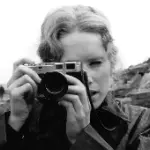I was lounging on my couch, mindlessly scrolling through my phone, when a strange piece of news caught my eye and totally reeled me in: David Lynch was auctioning off his personal belongings. And no, not some fancy, polished art pieces—but his actual day-to-day stuff. We're talking a mug printed with “Absence of Entropy,” a few cameras he used, a beat-up fabric couch, and yes—his worn socks (I’m not making this up).

Clicking into The David Lynch Collection website felt like stepping straight into one of his movies. It was like playing a surreal little game called “Interior Design, Lynch Edition.” Every object had this weird, haunted vibe. The mug looked like it could summon the dead. The cameras? Portals to parallel dimensions. The couch? Definitely a deleted scene from Mulholland Drive.
That’s when the question popped into my head:
What do other movie masters’ homes actually look like?
As someone who watched a lot of films, I know the movies well. But I’d never really thought about where these directors live. The spaces where they sit down to edit, make coffee, or just stare into space. I suddenly realized how little I knew—and that made me even more curious. So I started what felt like a low-key voyeuristic journey through the internet.
I began with Steven Spielberg. He’s my favorite director—I fell in love with film because of his works when I was a kid. Honestly, I figured it would be easy to find news about his house. He’s a big-name guy, not some underground artist hiding in a cabin. I expected interviews, maybe even a spread in Architectural Digest.
But nope—not much.
Steven Spielberg does own several properties. The most famous one is in Pacific Palisades, Los Angeles. The place is huge—about 3.5 acres—with a private theater, a swimming pool, guest houses… Variety and Architectural Digest have written brief pieces on it. But there are very few photos. You’ll find some blurry aerial shots or zoomed-in paparazzi street views, but its interior remains a total mystery.

Next, I looked into James Cameron . He had a Malibu beachfront mansion that he listed for $25 million in 2013. This house is even more cinematic than Spielberg’s: floor-to-ceiling glass walls, facing the Pacific Ocean, and a private beach access. Like, of course the guy who made The Abyss and Avatar would live in something that feels like a luxury submarine command center.

 Then came Quentin Tarantino . Based on his films, I imagined he might live in a Kill Bill-style Japanese courtyard, or maybe a basement with blood stains and VHS tapes everywhere.
Then came Quentin Tarantino . Based on his films, I imagined he might live in a Kill Bill-style Japanese courtyard, or maybe a basement with blood stains and VHS tapes everywhere.
Turns out—nope again. His home is in the Hollywood Hills, and it’s surprisingly… normal. Modern design, swimming pool, open courtyard. Kinda classy. Weirdly restrained. Maybe all his madness gets released on set, so his home can just be a place to breathe. 
Overall, my little research expedition led me to one conclusion:
Most directors really don’t want us peeking into their personal spaces.
Even though their films bring us deep into their imaginations, their homes remain private movie theatres—ones with scenes that only they get to watch.
Just when I was feeling a bit frustrated at the lack of interior photos, I stumbled across something that felt like a gift from the universe.
Illustrator Federico Babina has a series called Archidirector—and it is brilliant. Each piece is a fictional house designed in the style of a famous filmmaker. But instead of drawing actual floor plans, Babina imagines the emotional architecture of their minds.
David Lynch’s house in the series looks like a factory caught in a dream. Dim lighting, twisted walls, endless doorways.

George Lucas ? His house is Star Wars in architecture form.

Tim Burton ? Full gothic fantasy. You can practically hear Danny Elfman music leaking from the walls.

These imagined homesies feel more real to me than the actual ones I had been looking for.
Because they aren’t about wealth or square footage. They aren’t bragging about price tags or pools. They are raw portraits of personality.
We always say, “a filmmaker is the reflection of their work.” But most of their movies are polished, team-built, market-tested. If you really want to see the person behind the legend, you gotta look at what they don’t share: their clutter, their coffee mugs, their random junk drawer.
Where does Lynch sleep? What kind of camera does he use to take pictures of his dog? What design is on his favorite mug?
These details don’t carry any plot. They’re not “meaningful.” And yet… they kind of are.
Because in those fragments, you see the obsessive quirks, the secret comforts, the weird fears. That’s probably why I’m so fascinated with directors’ homes.
Movies are expansive. Complex. Often too perfect.
But homes? They’re messy. Soft. Real.
When you see a half-empty bottle of Tabasco in a director’s kitchen, or a torn-up slipper next to the bed—that’s when they stop being movie gods and turn back into people who lose the remote just like the rest of us.
So yeah—homes aren’t just functional. Especially for creators, they’re like mental maps.
Some people build luxury bunkers to hide from their anxiety. Others create three screenplays from a single worn-out couch. Homes are our shells, but they’re also our escape plans.
When we snoop around directors’ homes, maybe what we’re really doing is asking them—quietly, curiously—
“Who are you, really?”
Catch you later for more movie musings!






















































View replies 1